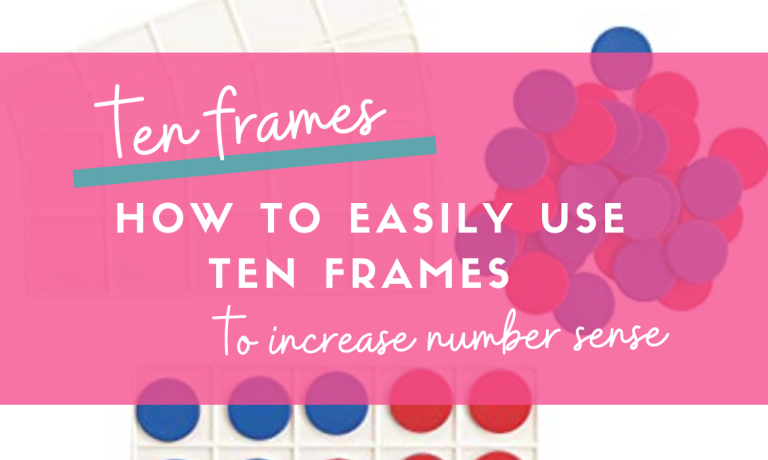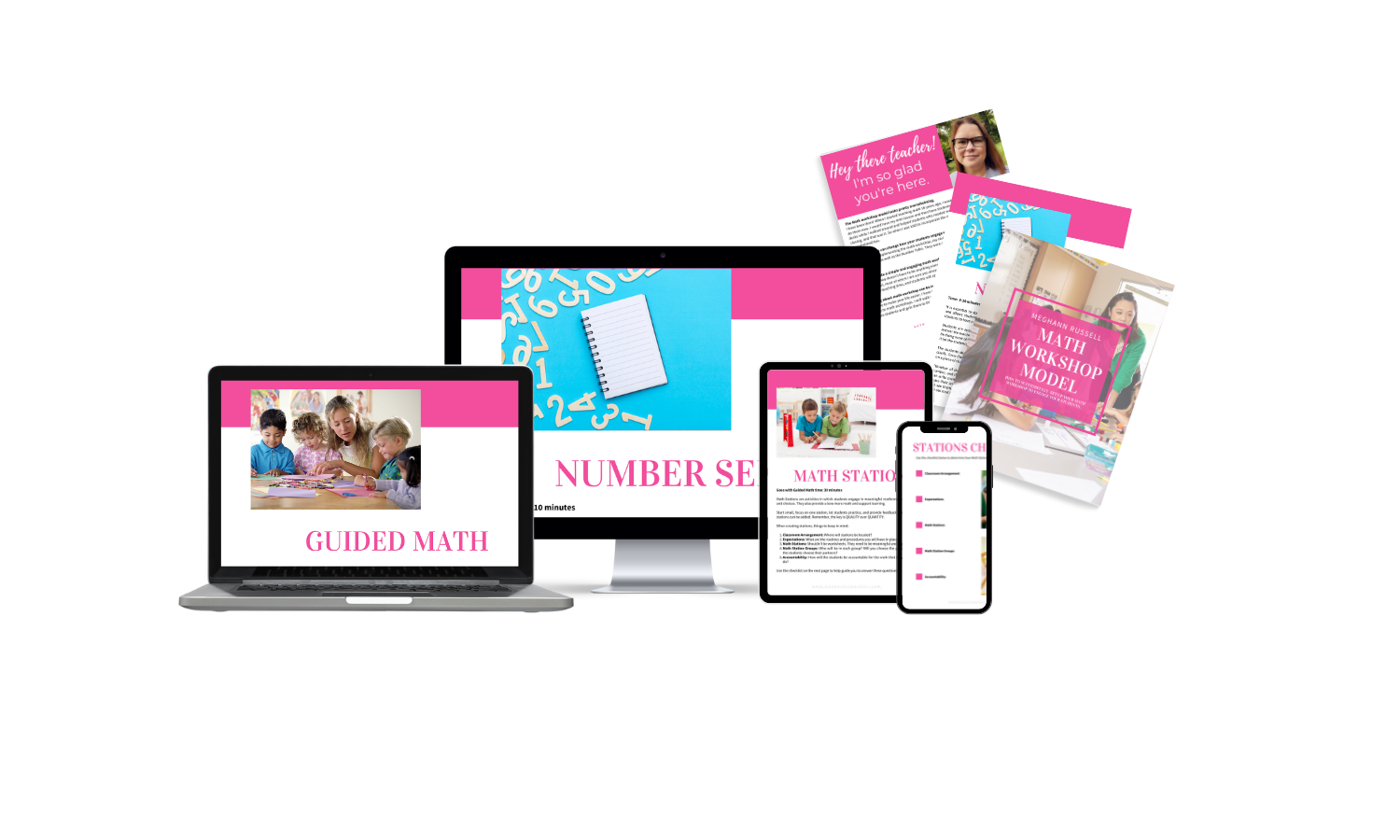We see ten frames all over math sites and frankly all over Instagram. There are so many great uses for ten frames! However, teachers may be thinking they know they have to use them but may not know why it’s so important, even in the upper grades, because they are dealing with more complex number problems. I’m going to tell you why it is important to use ten frames, and some easy ways to incorporate them in the classroom.

What is a Ten Frame?
A ten frame is a two-by-five rectangular frame in which objects like counters can be placed to show numbers less than or equal to ten. It is designed to help students see numbers within 10 and how to group numbers to make ten, which makes adding or subtracting past ten easier.

How do Ten Frames Help Students?
Ten frames are a wonderful tool to help children “see” numbers up to ten. When counters or dots are organized in a straight row it makes visualizing numbers easier. For example, you can use ten frames as flashcards and have students use them to subitize numbers (how many counters there are and students know without counting each one).
Ten frames help to build a visual representation of a given number and show students the value of a number. For example, if you had the number 6, that could be shown in many ways on the ten frame. You could have three counters on the top row, and three on the bottom row. Students know that they can break apart six into three and three. You could also have five counters on the top row and one counter on the bottom row. Students know they can break six apart in another way five and one. This strengthens student’s number sense and works on their number bonds, easing students into addition and subtraction.
Ten frames also help with building those missing addend facts by having a visual representation of number bonds. For example, a student can look at a ten frame and see that there are 6 counters on the ten frame. Then you can ask how many more counters they need to get to 10. (6 + _ = 10) Students can look at the empty spaces and see that they need four more counters to make ten.
Ten frames are also a great foundation for place value. Students learn that when a ten frame is full they need to start a new ten frame and count what is left over. For example, there is a full ten frame, and four counters left over. Students know they have one full ten frame, and four leftover (or 4 ones). It is a great visual for students to understand place value.
How to Use Ten Frames In Math
Now that I have shared why ten frames are important and how they help students in the classroom, I will show you how I use ten frames in my classroom to strengthen my student’s number sense with these quick and easy lessons.
Quick Images with Ten Frames
This is one of my favorite activities I use, and I love using it with my Number Talks. Quick Images are perfect for recognizing numbers and matching numbers to dot images. I usually do this on Google Slides. First, I start with a screen that has a black/grey box. I tell students that there will be dots behind the box and they will have 2-3 seconds to look at the image, then I will cover it back up and then ask how many dots they saw. The images can be dots that are scattered or on a ten frame, depending on what I am teaching at the time.

I show my students what is under the box and I give them 2-3 seconds to see how many dots are under the screen. Then I cover it back up. Next, I ask students how many dots they saw. I take as many answers as time will allow. From here I then reveal the answer by showing them the image again.
Then I ask the students to share what strategies they used to figure out the answer. While they are explaining their answer, I am writing it down on a whiteboard, chart paper, whatever I have available. This way the other students can see the visual representation of what other students are explaining. I call on as many students as possible so they can share their ideas. This is the most important part because students are exchanging ideas with each other and sharing their strategies. It helps others find different ways to solve problems and I find that learning from each other is just as effective if not more than me telling them other strategies. So try out this activity when you have a chance!
Fill in the Ten Frame
This activity is played 2 different ways and is another Number Talks that I use in the classroom. The first way to use this activity is just by having students understand numbers. I will give students a ten frame and some counters (I love using those erasers from Target or Five Below). I will flash a number (for example 8) and have students make that number using their ten frames. When they make one way, I have them share their ways and I write them on the board (4 and 4, 5 and 3). Then I challenge them to find another way to make that number. They love trying to come up with new ways to make a number.

The second activity I use this for is missing addends. I will ask students to make a number, for example, 7. Then I will ask them how many more counters they need to make 10. Students can simply count the number of blank boxes to determine the answer. I also have students explain their thinking and how they got to their answers.
Adding and Subtracting with Ten Frames
Ten frames are perfect for adding and subtracting numbers. For this activity, I usually use double-sided colored counters and ten frames. Again, I approach this in 2 ways. The first way is to give students 2 numbers to add using the ten frames. For example, I would give my students the addition problem 4+3 and they would use one color (red) to make four and the other color (yellow) to make three. Then students would look at the ten frames and see that the answer is seven. I would also use this for subtraction as well.
Another way I use ten frames for adding and subtracting is by giving students a number and then ask them to find ways to make that number using the colored counters. Once the students have shown their ways (and yes, they have to find multiple ways), I have them share their answers and write them on the board so other students can see what their classmates have created.
Interactive Notebooks
After I have worked on a concept with my students for a few lessons, I have them practice that skill by using an interactive notebook. These notebooks usually consist of a sorting activity, or a cut and color activity.

One activity I have students do with ten frames is filling in a ten frame. For example, students have four black dots and they need to find out how many red dots they need to get to ten. Students can simply fill in the dots in the ten frame to find the answer.
This is a quick informal assessment to see which students understand the concept and which don’t. Interactive notebooks also are great for documentation. You might need to show a student’s growth over time or need work samples. Their work is all right there in a book and you don’t have to scramble to find papers that you need for a meeting!
Ten Frames are Important
Ten frames are important for students to understand numbers to ten and help students “see” numbers. When counters are organized in a straight row it makes visualizing numbers easier. You can use ten frames as flashcards and have students use them to subitize numbers. Using Quick Images, filling in a tens frame, adding and subtracting, help students gain a true understanding of numbers and make math life so much easier for them as they progress through the grade levels. These simple activities can be used in the classroom and don’t take a lot of time or prep time either (which is a plus!)
Let me know in the comments your favorite activity that you tried or that you like to use with ten frames!

Activities
Math Interactive Notebooks for the Classroom
Related Articles
10 Awesome Manipulatives for Math Centers
How to Teach Number Talks Numbers to 10
Enhance Early Math Skills With These Clever 10 Frame Activities



